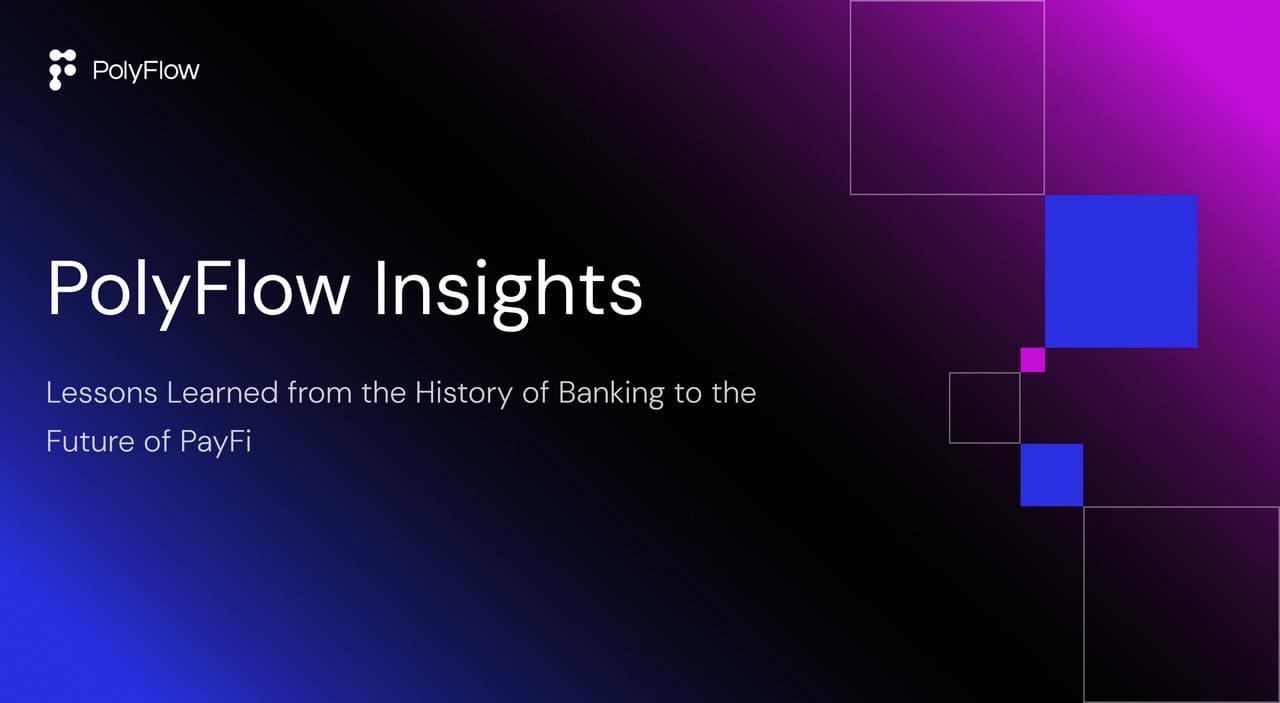PolyFlow Insights: Lessons Learned from the History of Banking to the Future of PayFi
Stablecoins, as a payment innovation, have simplified the way value is transferred. These digital currencies, typically pegged to the US dollar, serve both as a store of value and a medium of exchange. Despite being in development for only about five years, stablecoins have emerged as a “killer app” in the crypto space, creating a market parallel to traditional financial infrastructure with their annual transaction volumes surpassing those of major payment networks. With millions of users and t

Stablecoins, as a payment innovation, have simplified the way value is transferred. These digital currencies, typically pegged to the US dollar, serve both as a store of value and a medium of exchange. Despite being in development for only about five years, stablecoins have emerged as a “killer app” in the crypto space, creating a market parallel to traditional financial infrastructure with their annual transaction volumes surpassing those of major payment networks.
With millions of users and trillions of dollars in transactions, stablecoins have become a significant part of the financial ecosystem. However, the definition of this category and people’s understanding of it remain vague. Let alone the transformative role of PayFi.
By examining history, specifically the rise and fall patterns within the banking industry, we can gain insights into the current development trends of stablecoins and better foresee the future of PayFi. A16z partner Sam Broner’s article, “A useful framework for understanding stablecoins: Banking history,” offers valuable perspectives on the future development of stablecoins by drawing parallels with the history of the U.S. banking industry. This analysis also sheds light on the potential future of PayFi and beyond.
Historical Path of Banking
Like many innovations in the crypto space, stablecoins may follow a developmental trajectory similar to that of the banking industry. They begin with the issuance of stablecoins, akin to basic bank deposits and notes, and gradually evolve to encompass on-chain DeFi activities, ultimately leading to the development of PayFi.
Sam Broner’s article provides an introduction to the history of banking in the United States, offering valuable insights into the development of stablecoins. Before the establishment of the Federal Reserve and the FDIC, different forms of money had varying values based on the issuer’s reputation and the ease of redemption. Banks had to balance the need to invest in deposits to generate profit while ensuring the safety of those deposits. This tension is mirrored in the current landscape of stablecoins.
If fiat-backed stablecoins represent the current stage of money issuance widely adopted by the public, asset-backed stablecoins are likely to be the choice for the next stage of credit creation in the crypto space. Today, banks use deposits to invest in various assets, including loans, which are crucial for increasing the money supply and enhancing capital efficiency. Similarly, stablecoins offer functionalities akin to bank deposits and notes but in a decentralized, self-custodial form. As decentralized lending protocols mature, asset-backed stablecoins are expected to gain popularity, mirroring how banks expanded the money supply through lending.
This is where PayFi comes into play. PayFi builds, expands, and deepens stablecoin payment networks. By leveraging blockchain and smart contract technology, PayFi integrates DeFi protocols to offer on-chain financial services such as lending, wealth management, and investment on a global scale. By integrating payment and financial services using blockchain as the settlement layer, PayFi harnesses the advantages of stablecoin payments and DeFi to enhance efficiency and enable seamless value transfer.
Types of Stablecoins
Sam Broner’s article categorizes stablecoins into three main types: fiat-backed, asset-backed, and strategy-backed synthetic dollars (SBSDs). Fiat-backed stablecoins are comparable to banknotes from the National Banking Era, as they are directly redeemable for fiat currency and backed by reserves. Asset-backed stablecoins mimic the way banks create new money through lending, utilizing on-chain, highly liquid collateral.
SBSDs, due to their technical structure, are inevitably subject to regulatory challenges and user experience obstacles. Currently, they are primarily used as investment vehicles within DeFi products and struggle to overcome the traditional finance investment dilemma: the trade-off between yield, liquidity, and risk. This makes them unsuitable as a reliable store of value or medium of exchange.
Recent innovations, such as interest-bearing stablecoins backed by U.S. Treasury bonds and innovative models like PayFi, are breaking these financial investment limitations. PayFi integrates DeFi into payments, transforming every dollar into intelligent, autonomous funds. It converts idle funds into productive assets, generating returns while maintaining liquidity, effectively making every dollar count.
As more of the economy shifts onto the blockchain, anticipate the two key developments: a broader range of assets becoming suitable as collateral for lending protocols, and asset-backed stablecoins constituting a larger share of the on-chain money supply. Over time, other types of loans are likely to be safely issued on-chain, further expanding the on-chain money supply. While stablecoins alone cannot achieve this transformation, PayFi can.
Key Takeaways
While stablecoins’ innovations in payment systems may appear to disrupt traditional finance, it is essential to recognize that the fundamental attributes of money (as a measure of value) and its core functions (as a medium of exchange) remain constant. Thus, stablecoins can be viewed as carriers or manifestations of money.
Given their monetary essence, the patterns observed in the development of modern banking history over the past few centuries offer valuable insights. This is where Sam Broner’s article is particularly valuable, as it not only examines the issuance of money but also highlights how banks later utilized credit as a tool for money creation. This perspective provides a clear future direction for stablecoins, which are currently in the stage of money issuance.
Fiat-backed stablecoins represent the current phase of money issuance that is widely adopted by the public. In contrast, asset-backed stablecoins are poised to become the choice for the subsequent phase of credit creation. As more illiquid real-world asset (RWA) tokenized assets enter the blockchain, their primary role is not to circulate but to serve as collateral, forming the underlying assets for credit creation that support these asset-backed stablecoins.
Strategy-backed synthetic dollars, primarily used in DeFi yield products, struggle with the traditional finance investment dilemma: the trade-off between yield, liquidity, and risk. With PayFi’s integration with DeFi into the crypto space, it will eventually transform every dollar into intelligent, autonomous funds, including SBSDs, making every dollar count.
Ultimately, focusing on the essence is key: the creation of stablecoins, synthetic dollars, or dedicated currencies aims to further emphasize the fundamental attributes of money through digital currency and blockchain technology. For PayFi, the goal is to enhance its core functions, improve the efficiency of money operations, reduce operational costs, strictly control risks, and fully leverage the positive role of money in facilitating value exchange and driving economic and social development.
PolyFlow is paving the way for PayFi
Stablecoins are poised to revolutionize the payments industry by offering a cheaper and more efficient way to send money. PayFi is further driving the adoption of stablecoins in their next phase, much like the path of banking development, by creating money supply through credit.
For PolyFlow, the mission is clear: build solutions that connect traditional systems with blockchain, making every transaction count. As a foundational PayFi infrastructure, PolyFlow harnesses advanced blockchain technology to drive innovative applications, accelerating adoption and guiding users toward a new financial paradigm. It aligns with the original vision of the Bitcoin whitepaper, unlocking the full potential of Web3.
SOCIALS
To find out more about PolyFlow and keep up with our latest developments, follow the official channels.
📣Mirror | 💬 Global Community | 👾 Discord| 🐦 Twitter/X | 🌐 Website
CONTACT US
support@polyflow.tech

PolyFlow Insights: Lessons Learned from the History of Banking to the Future of PayFi
Stablecoins, as a payment innovation, have simplified the way value is transferred. These digital currencies, typically pegged to the US dollar, serve both as a store of value and a medium of exchange. Despite being in development for only about five years, stablecoins have emerged as a “killer app” in the crypto space, creating a market parallel to traditional financial infrastructure with their annual transaction volumes surpassing those of major payment networks. With millions of users and t

PolyFlow Insights: Could Tornado Cash’s Victory Be a Litmus Test for PayFi?
The Emergence of PayFi and Its Role in Decentralized Finance In a significant statement at the Russia Calling forum on December 4, Russian President Vladimir Putin remarked, “Who can prohibit Bitcoin? No one can. Who can prohibit the use of other electronic payment methods? No one can either. Because these are new technologies.” These words underline a crucial truth: technologies like Bitcoin and blockchain-based payment methods are not just innovations; they’re unstoppable movements. At the

PolyFlow Insights:How PayFi Transforms “Buy Now Pay Later” into “Buy Now Pay Never”
Over the past decade, “Buy Now Pay Later” (BNPL) has gained widespread adoption in the global e-commerce payment sector, particularly among younger consumers. By 2025, BNPL services are projected to account for 12% of global e-commerce spending on physical goods. Meanwhile, with the rise of the crypto wave, PayFi — a may be a groundbreaking application combining smart contracts, blockchain technology, and decentralized finance (DeFi) — is offering consumers a payment experience akin to “Buy Now